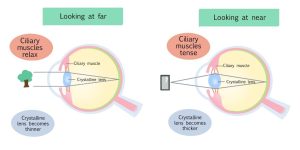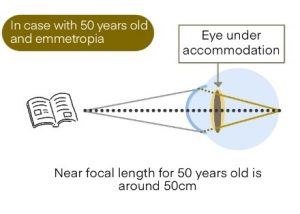 <Early symptoms of presbyopia that you should be aware of>
<Early symptoms of presbyopia that you should be aware of>
・Feeling of eye fatigue
・Blurred vision
・Headache and stiff shoulders
・Difficulty in seeing in dimly lit places
・Difficulty in reading fine print
When you think “I have presbyopia?”, try to reduce the strain on your eyes. It’s also important to visit an ophthalmologist for a consultation.
It’s a natural phenomenon for the eyes to become more tired with age. When you feel eye fatigue, it’s important to rest your eyes first. When working continuously, it’s advisable to take a break of 10 to 15 minutes per hour.
Presbyopia isn’t a disease, but with age, serious diseases such as cataracts, glaucoma, and fundus hemorrhage may be hidden. If you have any symptoms that concern you, an ophthalmologist can help detect and treat them in their early stages. This is very important to reduce the progression of the disease and to make it easier to see the effects of treatment.
There are two ways to deal with presbyopia.
Correction with reading spectacles or contact lenses
People tend to avoid reading glasses because of their image, but putting too much strain on your eyes can lead to unnecessary fatigue of the eyes and body. Consult with an ophthalmologist and use appropriate reading glasses or contact lenses to reduce the strain on your eyes
Since the aging of the eyes continues until around age 60, your vision may become degraded several years after prescribing glasses or contact lenses. If your vision becomes impaired, consult an ophthalmologist and have new glasses or contact lenses made each time.
Use eye drops
Choose over-the-counter eye drops that contain ingredients that improve the deterioration of the accommodating function of the eye.
An ophthalmologist can also prescribe eye drops to improve eye accommodation function of the eyes, which can be effective if used before working on a computer or feeling eye fatigue.



 <Early symptoms of presbyopia that you should be aware of>
<Early symptoms of presbyopia that you should be aware of>